My first venture into making artisanal (ha!) style whole-wheat bread has been…interesting.
Here’s the deal: I have a favorite 100 percent whole-wheat bread, from Farm to Market Bread Co., that I like to use for sandwiches. It’s tasty, has a nice texture and is local, more or less. (It’s from Kansas City, about 40 miles down the road.) It’s also $5.50 per one-pound loaf and is cruelly proportioned such that two slices seem like too much bread and one slice doesn’t seem like quite enough. Hence, I’d be pleased if I could make a satisfactory loaf.
My all-whole-grain loaf
Making it myself
I’ve been thinking for a while it would nice to be able to make a good, all-whole-grain bread myself, but I hadn’t seen any appealing recipes until I read Mark Bittman’s column on whole-grain bread. The column talks primarily about a quicker loaf in a previous column but provides instruction for a no-knead version more like baker Jim Lahey’s. Those are the instructions I followed. At least I think that’s what I did, as Bittman’s slow-fermentation instructions are given as sort of an aside.
In any case, here is what I did, in words and pictures. If anyone out there has made this recipe, I hope you’ll let me know if I did it right. Lacking experience with this kind of loaf, I’m not totally clear on whether I got the expected results.
Not-so-fast no-knead whole wheat bread
- 2 cups whole wheat flour (local!)
- 1/2 cup whole rye flour
- 1/2 cup coarse cornmeal (mine was regular old cornmeal)
- 1/2 teaspoon instant yeast
- 1 1/2 cups water
- 1 1/2 teaspoons salt
- Oil as needed
1. Combine flours, cornmeal, yeast and salt in a large bowl. Add water and stir until blended; dough will be shaggy. That’s what Bittman said, “shaggy.” What the heck does that mean? Beats me. I can tell you, however, the mixture comes together in a snap and has a rough texture, as perhaps you can see in the photos.
2. Cover bowl with plastic wrap. Let dough rest about 24 hours at warm room temperature, about 70 degrees. Finding a spot that warm in my house was the biggest challenge, but I discovered one spot near the middle of the house that kind of traps warm air behind a door. Yea! Remarkably enough, this curious mixture did rise.
3. Oil an 8- by 4-inch loaf pan. Turn dough into pan and press to the edges. (The original instructions have you shape it into a rectangle before placing it in pan. My dough was far too soft to do so. You’re also supposed to oil the top; I forgot.) Cover with plastic wrap, and let rest 2 hours or more.
4. Bake bread at 350 degrees for 50-55 minutes, or until loaf reaches an internal temperature of 210 degrees. I used a thermometer, as the bread didn’t look promising after the originally specified 45 minutes’ baking time. Mine came out of the oven at 53 minutes, although it may still have been a little shy of 210 degrees.
5. Remove bread from pan and cool on a rack. Bittman said a nonstick pan works well. Might be a good idea. I don’t have a nonstick pan of the specified size, and it took a little work—knife around the edge and several good whacks—to dislodge the bread. Makes 1 loaf.
The final result
The bread is quite different from any yeast bread I can recall eating. The texture is fairly coarse and the middle is oddly moist—not gummy, but not far from it. It slices well.
Bittman says this bread can sit “for days” at room temp wrapped in a kitchen towel. Mine did, but before it developed the moisture content, as well as the density and appearance, of a brick I cut what was left into a couple of hunks and put them in the freezer. It also freezes and thaws well.
Again?
I’ll probably try it again, just to see if I get different results. I might add a tablespoon of honey or something to boost the flavor a bit. I gather that the loaf photographed at the link above is the quick version of this bread, which includes more yeast and shorter rising times. I don’t know if that explains the apparent finer crumb he got, based on the NYT photo.
In any case, I’d love to hear from anybody who tries this recipe. It truly could not be simpler, but I’m not sure that I might not be happier with a loaf that requires more effort and yields a finer texture. That may be the ticket with the recipe he provides for All Whole Wheat Sandwich bread, whose ingredients include added gluten, sweetener and milk.

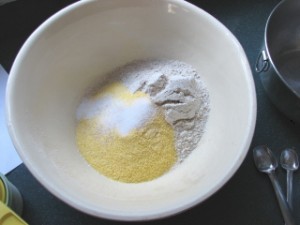
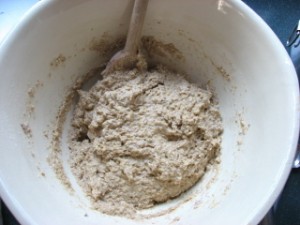
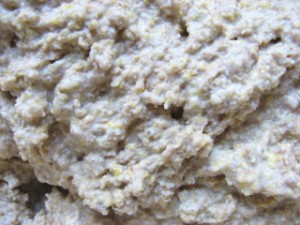
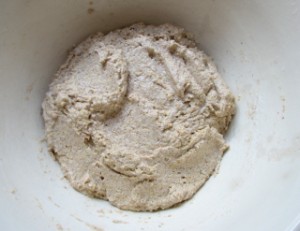
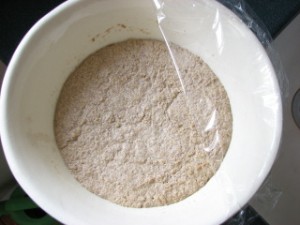
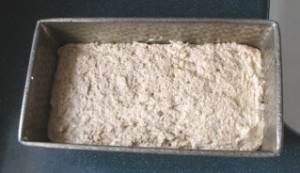

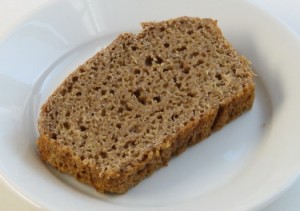
Joanne // Jan 2, 2009 at 4:24 pm
I make a lot of whole grain breads, and I use versions of the no-knead bread recipe. I find that in order to get a big round loaf that rises well and has a nice crust, it needs some white flour…otherwise it is just too dense. While whole grain wheat/rye recipes can work, they are extremely dense on their own. I usually make an enormous amount at once. My wheat recipe has in it:
4 cups whole wheat flour
1 cup oatmeal
4 cups white flour
1 tsp yeast
1 tblspoon salt
41/2 cups of water.
cornmeal to avoid stickiness
I let it rise about 14-18 hours, I let it rest as rounded loaves for 2 hours, I bake in two cast iron dutch ovens at 450, 30 minutes with tops on, and 15 minutes without. I can send you a more formal recipe via email if you like.
Gumminess or moisture means your bread probably didn’t rise enough or wasn’t cooked enough.
While my recipe isn’t 100% whole wheat, it’s got cornmeal and oatmeal in it, too. I also have a seven grain and a rye recipe, but everything has to be cut with white flour just to avoid that density problem. This has something to do with the nature of commercial flours on the market as well as our 21st expectations of bread! Hope all this helps.
I have made this before, and yes it came out spongy. I experimented with it for more than a month as I was determined to get a no-knead whole grain soaked flour sandwich loaf.
The end result? I bought my first Kitchen Aid Pro stand mixer and started using it to knead my bread!
I get pretty perfect loaves every time, and I don’t have to do the intense labor of kneading a 100% whole grain loaf (compare 45 minutes of kneading by hand with 8 minutes in the mixer).
Janet Majure // Jan 3, 2009 at 1:07 pm
Thanks, Joanne. Sounds like a winner, although I was hoping to find something with less white flour. Bittman’s other recipe, which includes the addition of wheat gluten, may be the ticket.
What recipe do you use, FoodRenegade?
I was once told that the way to master bread is to find one recipe and experiment with it until you know how it works in and out. I’ve been doing that for each type of loaf, slowly but surely.
This is my daily sandwich bread recipe, tweaked for my family’s tastes. I’m planning on posting a tutorial on this on my site soon, but here’s the recipe I created:
Nourishing Traditions Friendly 100% Whole Wheat Sandwich Bread
3 1/2 C freshly ground whole wheat flour + 1 tbsp of vital wheat gluten
1 C warm water + 1/4 C homemade whey
->Mix together and let sit overnight in a covered mixing bowl.
1/8 C warm water
2 tsp. molasses
2 1/4 tsp yeast
1 tsp salt
1 tsp baking soda
->Mix in a glass measuring cup, adding one ingredient at a time in the above order, stirring well between each addition.
->Pour this liquid mixture into your soaked flour.
->Mix dough in stand mixer on lowest setting, adding in up to 1/2 C of additional flour. Pause mixer and try to form a ball with the dough. It should not form at all. Turn mixer on lowest setting then slowly add up to 1/8 C of of additional warm water and 1/8 C of oil, pausing mixer periodically to test dough consistency. Keep adding oil in small dribbles until dough holds the shape of a ball when tested. Then, use stand mixer to knead dough for 8 additional minutes.
->Let dough rest for 20 minutes, then knead for 5 more minutes.
->Remove dough from mixer, shape loaf, and let rise in a large loaf pan covered with oiled plastic wrap.
->Preheat oven to 450F with an aluminum foil lined cast iron skillet on bottom. Let loaf rise to an inch or an inch and a half above the loaf pan’s rim. Place loaf in oven on center rack. Throw a handful of ice cubes in the skillet and close the oven door. After 5 minutes, lower the heat to 400F and bake for an additional 30 minutes. This helps create a nice crust and promotes oven rise.
->Remove loaf from oven and pan and let cool on a wire rack before slicing.
You can see a picture of a finished loaf here:
http://tinyurl.com/8d3drg
Susan G. // Jan 3, 2009 at 7:59 pm
Hi Janet:
as you know I make quite a bit of bread, though not much whole grain (which I need to remedy). I did however, take a class on making better bread and this was discussed. As Joanne said - add white flour. I know that may not be what you have in mind, but work with whole wheat-even with white flour in it-is exhausting and can be not very tasty. I also concur that adding gluten, sugar, etc. will help soften the dough and make it more flavorful. I also thought the amount of yeast seemed small.
I believe, too, when you make such a small loaf, there’s not much room for error. When you are working with 4-8 total cups of flour, things are a little more forgiving.
Kneading, while tedious, ought to be a snap for a weight liftin’ chick like you! Or certainly mixer/breadmaker help could get you there.
Lastly, if you’re not looking for a specific and lower temp for rising, the top of the fridge is my favorite spot. Steady warmth and no drafts.
Good luck!
Susan
Janet Majure // Jan 4, 2009 at 2:03 pm
Gorgeous loaf, KR! And recipe’s a little complicated, but I’ll keep it in mind.
Thanks, too, for your tips, Susan. I guess I can mull everyone’s suggestions as I finish the brick loaf. I do have a mixer, so that can save a lot of labor.
I just want a loaf that looks like KR’s but is as easy to make as the one I made. Is that asking too much? Alas, it obviously is!
I know it *seems* complicated, but it really isn’t! I swear.
Most of the instructions are there to help the newbie understand how to get whole wheat dough “smooth & elastic.” Your average bread recipe simply tells you ingredient amounts and says you’re to mix them all up, then knead until “smooth & elastic.” It sounds so simple!
Well, I spent a whole year baking whole wheat breads before I hit upon a really “smooth & elastic” dough. The reason it requires adding oil and water in such imprecise dribbles is because a thousand things can change what amounts you’ll ACTUALLY need to make the dough smooth & elastic — humidity, temperature, season of year, the imprecision of your measurement techniques, etc.
Oh, and the overnight soaking can be done away with if you’re using sprouted grain flour. It’s mostly there for health purposes. Soaked, sprouted, or fermented grains are so much easier to digest and they’re far more nutrient-dense too (I’m sure you know this already).
Seánan // Jan 5, 2009 at 6:36 pm
I may be a freak, but I like kneading. Maybe it’s a matter of habit; I grew up making bread that way.
Your ‘cold’ comment reminded me of baking for open-houses when I was in my ‘teens. I did a lot of baking late at night, If the air was cold, then I’d tuck the bread, covered in its bowl, beneath my blankets and let my body heat warm the dough.
It’s been a long time, but I think I’d do it again.
Janet Majure // Jan 6, 2009 at 8:16 am
Seanan, I laughed at the image of crawling into bed with a bowl of dough. I’d wind up wearing it! And I don’t mind kneading, but I love the idea of having a really good loaf of homemade whole-wheat bread that doesn’t require me to plan my day around it.
Maybe one day I’ll try FoodRenegade’s recipe, but it’s one of the plan-around-it variety!
Joanne // Jan 6, 2009 at 12:06 pm
I’ve been following the conversation-and you know, part of the reason I am willing to go with some white flour (organic unbleached, of course) is that I don’t have to deal with gluten, sweetener, milk products, or other additives. It’s just grains, (some whole grains), yeast, salt, and water, and the recipe is pretty simple. Compared to most commercial breads, I’m convinced that has to be better for you in any event…although of course, more whole grains generally are a good thing.
Janet Majure // Jan 7, 2009 at 12:44 pm
Good points, Joanne, although I did pick up some gluten at the store yesterday!
Second try at 100% whole wheat bread better | foodperson.com // Jan 19, 2009 at 11:12 am
[…] Bread, both of which he discussed in his NYTimes column. If you don’t remember that one, here’s my report on it. It was as bricklike as promised, a little too leaden for my […]
valerie // Jun 4, 2009 at 8:29 pm
Food Renegade, I have been looking for just such an approach to bread making using soaked and sprouted fresh ground grains, the inclusion of whey (I make raw milk kefir and have whey on hand). I also have raw buttermilk and cream. Question, if I am sprouting then drying then grinding my own grain, will I gain additonal health benefits by also soaking? I know that you don’t have to but do I gain anything by it? I have an additional challenge with bread making, aside from being very new to it, I live at 9000 and am determined to make 100% whole wheat bread. Wish me luck.
Janet Majure // Jun 5, 2009 at 9:57 am
Hi, Valerie. Thanks for stopping by! Just in case she didn’t subscribe to the comments, I’ll let Kristen know about your comment. You’ll probably want to check out her blog, too: http://www.foodrenegade.com/.
The only thing you’ll gain is a slightly sour flavor. Nutritionally speaking, you don’t gain anything by soaking a sprouted grain flour.
Thanks, Janet, for letting me know about Valerie’s question!
Cheers,
KristenM
(AKA FoodRenegade)
whole grain flour // Oct 2, 2010 at 3:35 am
we are very happy . this food very much eat. relley
so good food. thanks you.